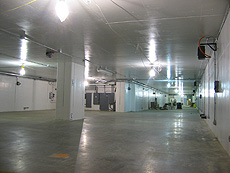Construction continues at accelerator test facility
 |
This newly constructed tunnel provides space for an extended beamline at the new accelerator test facility. |
Fermilab’s new accelerator test facilities at the New Muon Laboratory reached an important milestone last month with the completion of a tunnel extending from the previously existing building. The tunnel will allow room for the accelerator test facility to grow, giving physicists much-needed space to develop superconducting radio-frequency technology.
The new tunnel will host a 460-foot-long SRF test accelerator; the first of its kind in the United States.
Project Manager Jerry Leibfritz said the expansion is key to continuing SRF research at Fermilab for next-generation accelerators on the Intensity Frontier, such as the proposed Project X.
Fermilab also plans to use the new test facilities to test SRF components from industry to validate and further their accelerator manufacturing capabilities.
The new facility was built with several cost-saving measures in mind.
“We used recycled equipment wherever we could,” Leibfritz said. “A lot of components for the new facility came from other parts of the laboratory where they were no longer needed.”
The construction work provided jobs for several local subcontractors working for Michigan-based contractor Barton Malow Incorporated. A total of 27,802 manhours have been completed on the project to date with an average of 10 tradespeople on site each day for the past year.
Two additional buildings under construction will house accelerator component test stands and a large cryogenic refrigerator to cool the niobium superconducting accelerator cavities. SRF accelerators operate at -456 degrees Fahrenheit, a temperature where they can conduct electric current without electrical resistance.
Construction on the additional buildings is scheduled for completion later this year.
With the completion of the new accelerator test facility, Fermilab hopes to become a world leader in SRF technology. Physicists and engineers from one of the world’s top SRF accelerator laboratories, the German Electron Synchotron (DESY), collaborated with Fermilab on many aspects of the new facility.
Money for the expansion came from the American Recovery and Reinvestment Act. Additional ARRA funds are going towards the equipment and infrastructure needed for the building’s operation.
- Cynthia Horwitz
|